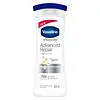Nivea Super 8 Extra Bright Radiant & Smooth Body Lotion Versus Vaseline Intensive Care Advanced Repair Unfragranced Body Lotion
What's inside
What's inside
 Key Ingredients
Key Ingredients

No key ingredients
 Benefits
Benefits

 Concerns
Concerns

 Ingredients Side-by-side
Ingredients Side-by-side

Water
Skin ConditioningGlycerin
HumectantIsopropyl Palmitate
EmollientAlcohol Denat.
AntimicrobialEthylhexyl Methoxycinnamate
UV AbsorberCetyl Alcohol
EmollientDimethicone
EmollientDistarch Phosphate
AbsorbentPhenoxyethanol
PreservativeButyl Methoxydibenzoylmethane
UV AbsorberMethylparaben
PreservativeCarbomer
Emulsion StabilisingTrisodium EDTA
Ethylparaben
PreservativeSodium Stearoyl Glutamate
CleansingAcrylates/C10-30 Alkyl Acrylate Crosspolymer
Emulsion StabilisingCera Alba
EmollientSodium Hydroxide
BufferingXanthan Gum
EmulsifyingSodium Ascorbyl Phosphate
AntioxidantPropylene Glycol
HumectantCreatine
Skin ConditioningPersea Gratissima Oil
Skin ConditioningMaltodextrin
AbsorbentSodium Chloride
MaskingCitrus Limon Juice
Skin ConditioningBHT
AntioxidantCitric Acid
BufferingCitrullus Lanatus Fruit Extract
Skin ConditioningMalpighia Glabra Fruit Juice
Skin ConditioningPrunus Persica Juice
MoisturisingTrideceth-9
EmulsifyingSodium Benzoate
MaskingCamellia Sinensis Leaf Extract
AntimicrobialCitrus Sinensis Fruit Extract
AntioxidantGlycyrrhiza Glabra Root Extract
BleachingMyrciaria Dubia Fruit Juice
AntioxidantPotassium Sorbate
PreservativeAscorbic Acid
AntioxidantBisabolol
MaskingParfum
MaskingCI 77891
Cosmetic ColorantWater, Glycerin, Isopropyl Palmitate, Alcohol Denat., Ethylhexyl Methoxycinnamate, Cetyl Alcohol, Dimethicone, Distarch Phosphate, Phenoxyethanol, Butyl Methoxydibenzoylmethane, Methylparaben, Carbomer, Trisodium EDTA, Ethylparaben, Sodium Stearoyl Glutamate, Acrylates/C10-30 Alkyl Acrylate Crosspolymer, Cera Alba, Sodium Hydroxide, Xanthan Gum, Sodium Ascorbyl Phosphate, Propylene Glycol, Creatine, Persea Gratissima Oil, Maltodextrin, Sodium Chloride, Citrus Limon Juice, BHT, Citric Acid, Citrullus Lanatus Fruit Extract, Malpighia Glabra Fruit Juice, Prunus Persica Juice, Trideceth-9, Sodium Benzoate, Camellia Sinensis Leaf Extract, Citrus Sinensis Fruit Extract, Glycyrrhiza Glabra Root Extract, Myrciaria Dubia Fruit Juice, Potassium Sorbate, Ascorbic Acid, Bisabolol, Parfum, CI 77891
Water
Skin ConditioningGlycerin
HumectantPetrolatum
EmollientCarbon
Stearic Acid
CleansingGlycol Stearate
EmollientTriethanolamine
BufferingDimethicone
EmollientEthyl Isopropyl-Bicycloheptene-2-Carboxylate
PerfumingTapioca Starch
Cetyl Alcohol
EmollientGlyceryl Stearate
EmollientMagnesium Aluminum Silicate
AbsorbentMethylparaben
PreservativePhenoxyethanol
PreservativePropylparaben
PreservativeDisodium EDTA
Titanium Dioxide
Cosmetic ColorantWater, Glycerin, Petrolatum, Carbon, Stearic Acid, Glycol Stearate, Triethanolamine, Dimethicone, Ethyl Isopropyl-Bicycloheptene-2-Carboxylate, Tapioca Starch, Cetyl Alcohol, Glyceryl Stearate, Magnesium Aluminum Silicate, Methylparaben, Phenoxyethanol, Propylparaben, Disodium EDTA, Titanium Dioxide
Ingredients Explained
These ingredients are found in both products.
Ingredients higher up in an ingredient list are typically present in a larger amount.
Cetyl Alcohol is a fatty alcohol. Fatty Alcohols are most often used as an emollient or to thicken a product.
Its main roles are:
Though it has "alcohol" in the name, it is not related to denatured alcohol or ethyl alcohol.
The FDA allows products labeled "alcohol-free" to have fatty alcohols.
Learn more about Cetyl AlcoholDimethicone is a type of synthetic silicone created from natural materials such as quartz.
What it does:
Dimethicone comes in different viscosities:
Depending on the viscosity, dimethicone has different properties.
Ingredients lists don't always show which type is used, so we recommend reaching out to the brand if you have questions about the viscosity.
This ingredient is unlikely to cause irritation because it does not get absorbed into skin. However, people with silicone allergies should be careful about using this ingredient.
Note: Dimethicone may contribute to pilling. This is because it is not oil or water soluble, so pilling may occur when layered with products. When mixed with heavy oils in a formula, the outcome is also quite greasy.
Learn more about DimethiconeGlycerin is already naturally found in your skin. It helps moisturize and protect your skin.
A study from 2016 found glycerin to be more effective as a humectant than AHAs and hyaluronic acid.
As a humectant, it helps the skin stay hydrated by pulling moisture to your skin. The low molecular weight of glycerin allows it to pull moisture into the deeper layers of your skin.
Hydrated skin improves your skin barrier; Your skin barrier helps protect against irritants and bacteria.
Glycerin has also been found to have antimicrobial and antiviral properties. Due to these properties, glycerin is often used in wound and burn treatments.
In cosmetics, glycerin is usually derived from plants such as soybean or palm. However, it can also be sourced from animals, such as tallow or animal fat.
This ingredient is organic, colorless, odorless, and non-toxic.
Glycerin is the name for this ingredient in American English. British English uses Glycerol/Glycerine.
Learn more about GlycerinMethylparaben is a preservative and is a paraben. It is used to prevent the growth of fungus, mold, and other harmful bacteria. Parabens are chemicals used as preservatives in both cosmetics and food.
Methylparaben can be synthetically created. It can also be found naturally in some fruits, such as blueberries.
Oftentimes, Methylparaben is combined with other parabens to help increase the shelf life.
The safety of Methylparaben is currently being studied. While ongoing studies are looking into the safety of parabens, the results have been very mixed. Some studies have not found Methylparaben to be harmful.
Learn more about MethylparabenPhenoxyethanol is a preservative that has germicide, antimicrobial, and aromatic properties. Studies show that phenoxyethanol can prevent microbial growth. By itself, it has a scent that is similar to that of a rose.
It's often used in formulations along with Caprylyl Glycol to preserve the shelf life of products.
Water. It's the most common cosmetic ingredient of all. You'll usually see it at the top of ingredient lists, meaning that it makes up the largest part of the product.
So why is it so popular? Water most often acts as a solvent - this means that it helps dissolve other ingredients into the formulation.
You'll also recognize water as that liquid we all need to stay alive. If you see this, drink a glass of water. Stay hydrated!
Learn more about Water